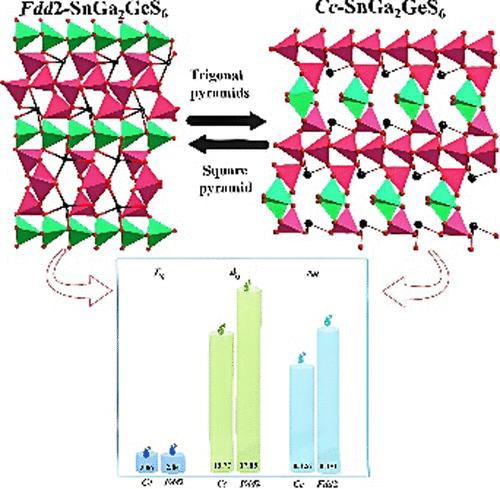利用原子配位工程调制α/β-SnGa2GeS6多晶的非线性光学性能
IF 4.7
2区 化学
Q1 CHEMISTRY, INORGANIC & NUCLEAR
引用次数: 0
摘要
基于结构变换的性质调制已成为开发高性能非线性光学晶体的关键策略。其中,结构多样、性能优异的多晶体系在NLO材料的研究中越来越受到关注。在这项工作中,调整Sn2+阳离子的配位环境(从SnS5到SnS3)可以发现另一个新的相,β-SnGa2GeS6,它在Cc基团中结晶,与之前报道的α-相(Fdd2)不同。详细的表征揭示了α-和β-多态性之间不同的NLO特性,包括NLO响应(α: 17.8 pm/V vs β: 13.7 pm/V)和双折射(α: 0.151 vs β: 0.126)。理论计算证实,偶极矩分析证实了β相NLO响应的降低是由[SnS3]单元的极化取消引起的。本研究强调了多晶系统中原子配位工程对结构转变和可调NLO性能的影响。这种在多晶中建立的“相变→结构转变→NLO特性”关系,为发现下一代NLO材料提供了一种设计范式。本文章由计算机程序翻译,如有差异,请以英文原文为准。

Modulating Nonlinear Optical Performances in α/β-SnGa2GeS6 Polymorphs via Atomic Coordination Engineering
Property modulation based on structural transformation has emerged as a crucial strategy for developing high-performance nonlinear optical (NLO) crystals. Among them, polymorphic systems with structural diversity and fascinating performances have attracted growing attention in the exploration of NLO materials. In this work, adjusting the coordination environment (from SnS5 to SnS3) of the lone-pair Sn2+ cation enables the discovery of another new phase, β-SnGa2GeS6, which crystallizes in the Cc group that is different from the previously reported α-phase (Fdd2). Detailed characterization reveals distinct NLO properties between the α- and β-polymorphs, including NLO response (α: 17.8 pm/V vs β: 13.7 pm/V) and birefringence (α: 0.151 vs β: 0.126). Theoretical calculations confirm that the reduced NLO response in the β-phase arises from the canceled polarization of the [SnS3] units, as evidenced by dipole moment analysis. This study highlights the influence of atomic coordination engineering in polymorphic systems for structural transition and tunable NLO performances. Such established “phase transition → structural transformation → NLO property” relationship in polymorphs provides a design paradigm for discovering next-generation NLO materials.
求助全文
通过发布文献求助,成功后即可免费获取论文全文。
去求助
来源期刊

Inorganic Chemistry
化学-无机化学与核化学
CiteScore
7.60
自引率
13.00%
发文量
1960
审稿时长
1.9 months
期刊介绍:
Inorganic Chemistry publishes fundamental studies in all phases of inorganic chemistry. Coverage includes experimental and theoretical reports on quantitative studies of structure and thermodynamics, kinetics, mechanisms of inorganic reactions, bioinorganic chemistry, and relevant aspects of organometallic chemistry, solid-state phenomena, and chemical bonding theory. Emphasis is placed on the synthesis, structure, thermodynamics, reactivity, spectroscopy, and bonding properties of significant new and known compounds.
 求助内容:
求助内容: 应助结果提醒方式:
应助结果提醒方式:


